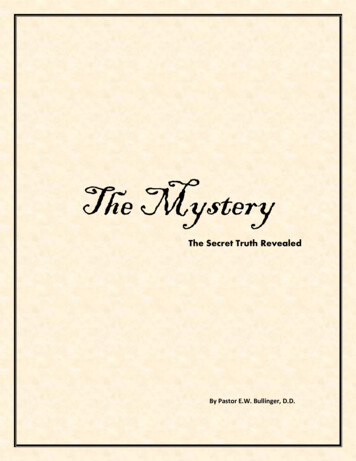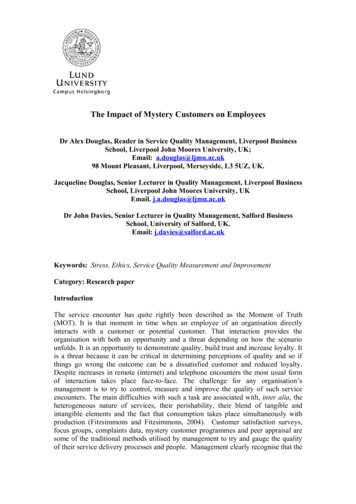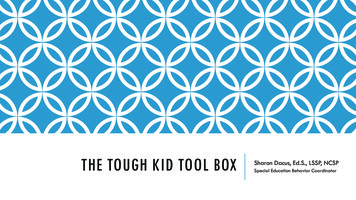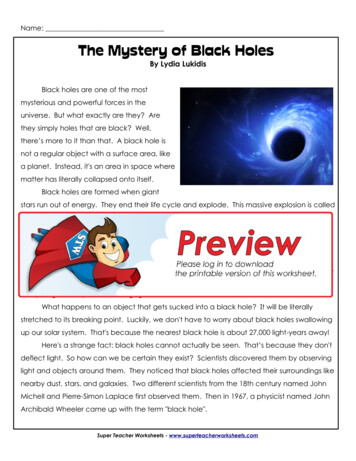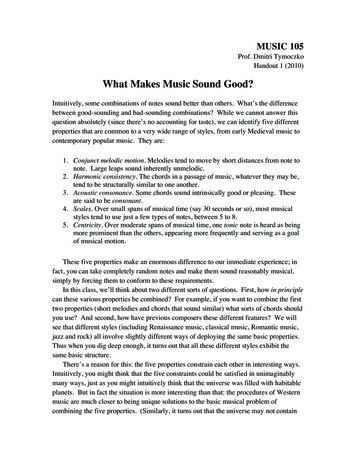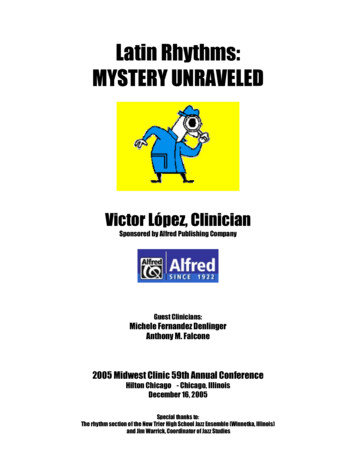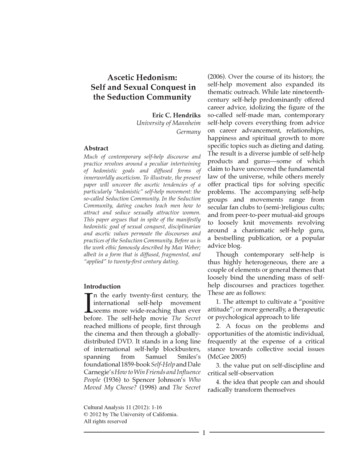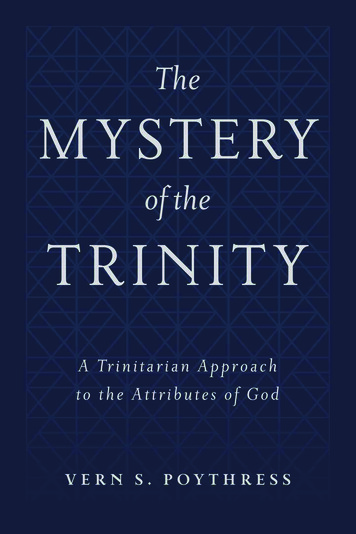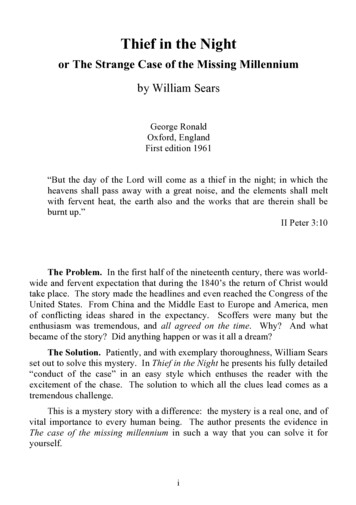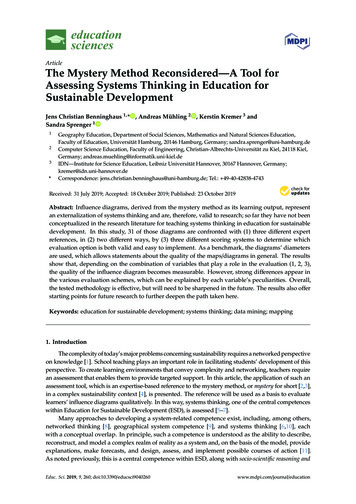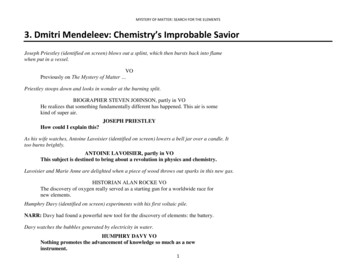
Transcription
MYSTERY OF MATTER: SEARCH FOR THE ELEMENTS3. Dmitri Mendeleev: Chemistry’s Improbable SaviorJoseph Priestley (identified on screen) blows out a splint, which then bursts back into flamewhen put in a vessel.VOPreviously on The Mystery of Matter Priestley stoops down and looks in wonder at the burning split.BIOGRAPHER STEVEN JOHNSON, partly in VOHe realizes that something fundamentally different has happened. This air is somekind of super air.JOSEPH PRIESTLEYHow could I explain this?As his wife watches, Antoine Lavoisier (identified on screen) lowers a bell jar over a candle. Ittoo burns brightly.ANTOINE LAVOISIER, partly in VOThis subject is destined to bring about a revolution in physics and chemistry.Lavoisier and Marie Anne are delighted when a piece of wood throws out sparks in this new gas.HISTORIAN ALAN ROCKE VOThe discovery of oxygen really served as a starting gun for a worldwide race fornew elements.Humphry Davy (identified on screen) experiments with his first voltaic pile.NARR: Davy had found a powerful new tool for the discovery of elements: the battery.Davy watches the bubbles generated by electricity in water.HUMPHRY DAVY VONothing promotes the advancement of knowledge so much as a newinstrument.1
MYSTERY OF MATTER: SEARCH FOR THE ELEMENTSANNOUNCER: Major funding for The Mystery of Matter: Search for the Elements wasprovided by the National Science Foundation, where discoveries begin. Additional fundingprovided by the Arthur Vining Davis Foundations – dedicated to strengthening America’s futurethrough education. And by the following.Episode Title: Unruly ElementsCHAPTER 1: Chemistry’s Unruly GardenAlignment with the NRC’s National Science Education StandardsB: Physical ScienceStructure and Properties of Matter: An element is composed of a single type of atom. A substance composed of a single kind of atom is called an “element.” The atoms may be bonded together intomolecules or crystalline solids. A compound is formed when two or more kinds of atoms bind together chemically.G: History and Nature of ScienceHistorical Perspectives The historical perspective of scientific explanations demonstrates how scientific knowledge changes by evolving overtime, almost always building on earlier knowledge.Alignment with the Next Generation Science StandardsScience and Engineering Practices1. Asking Questions and Defining Problems Ask questions to clarify and refine a model, an explanation, or an engineering problem.3. Planning and Carrying Out Investigations Plan and conduct an investigation individually and collaboratively to produce data to serve as the basis for evidence, andin the design: decide on types, how much, and accuracy of data needed to produce reliable measurements and considerlimitations on the precision of the data (e.g., number of trials, cost, risk, time), and refine the design accordingly. Select appropriate tools to collect, record, analyze, and evaluate data.2
MYSTERY OF MATTER: SEARCH FOR THE ELEMENTSFade up to reveal a single flame. A wire loop held in the flame burns bright yellow. A wide shotreveals the host holding the loop in the flame.HOSTOne of the oldest tricks in the chemist’s toolbox is called the flame test.EXAMPLE OF SCIENCE PRACTICE:asking questions and definingproblemsHe now puts a different substance into the flame. It burns red.HOSTMore than a thousand years ago, Arab alchemists discovered that everysubstance gave off a telltale color as it burned.He now puts in a series of elements that all burn shades of green.Notes from the Field:My kids appreciate seeing scientiststhat come from differentbackgrounds and that they are not allwealthy and privileged.HOSTBut as the number of elements grew, this test became less and less useful,because some elements gave off such similar colors it was hard to tell themapart.Host motions to photo of Bunsen and KirchhoffHOSTOne day in 1859, a German chemist named Robert Bunsen described thisproblem to his good friend, physicist Gustav Kirchhoff.STOP AND THINK 1: Up to this time, scientists had identified elements by determining the properties ofelemental substances. Because the properties of elements differ from the properties of compounds that containthose elements, scientists had used a variety of methods, including the battery, to decompose compounds intoelemental substances. How did the spectroscope change the way scientists looked for elements?Possible Student Answers: Spectra are emitted by elements no matter how they are combined with otherelements. Finding elements became much easier using this method; compounds no longer had to bedecomposed first.He motions to parts of spectroscope, then moves an element into the flame of the Bunsenburner.3
MYSTERY OF MATTER: SEARCH FOR THE ELEMENTSHOSTA few days later, Kirchhoff came to Bunsen’s laboratory with an instrumentmade from two telescopes, a wooden box and a prism. They used Bunsen’s latestinvention – the Bunsen burner – to heat their samples. Light from the burningelement passed down the barrel of this telescope to the prism, which split thelight into a spectrum of colors.Host now leans down to look into the eyepiece.HOSTWhat they saw when they looked into the eyepiece was a revelation.CONCEPT IN BRIEF: elementEXAMPLE OF SCIENCE PRACTICE:planning and carrying outinvestigationsWe cut to his point of view, revealing what he sees.HISTORIAN ALAN ROCKE, partly in VOYou see a whole collection of sharp bright lines at very particular wavelengths,and that map of lines is distinctive for every element.Animation reveals spectra of four distinct elementsPHYSICIST DAVID KAISER, partly in VOIt’s almost like each element has its own barcode. It’s a unique way of saying: this isthat element and not some other.Closeups of the spectroscope and host peering into itNARR: Like Humphry Davy’s battery, the “spectroscope” kicked off a whole new round in thediscovery of elements Composite image of Bunsen and Kirchhoff and the spectra of cesium and rubidiumCONCEPT IN BRIEF: importance ofscientific toolsCONCEPT IN BRIEF: spectroscopyNARR: starting with cesium and rubidium, discovered by Bunsen and Kirchhoff themselvesComposite image of the discoverers of thallium and indium and the spectra of those elementsNARR: quickly followed by thallium and indium, discovered by other chemists who seizedon their new tool.4CONCEPT IN DEPTH: Scientificknowledge evolves by using newevidence to build on earlier knowledge
MYSTERY OF MATTER: SEARCH FOR THE ELEMENTSImage: Astronomer looks into spectroscope attached to a telescope.NARR: Astronomers, too, embraced the new technology, turning the spectroscope to theheavens.Image of the solar eclipse and the spectrum of heliumPHYSICIST JIM GATES, partly in VOIn fact, there’s one element that we found by first looking at the sun. We didn’teven know it was here on earth. It was helium.CONCEPT IN BRIEF: elementAnimation showing unruly garden of elementsPHYSICIST DAVID KAISER, partly in VOBy the middle of the 19th century, there had been an explosion in the numbers ofnew elements that had been found. And this was exciting, but it also led to a kindof muddle that seemed to have no order, no reason behind it.HISTORIAN ALAN ROCKE VOChemistry looked like an unruly garden, a jungle of bewildering details.HISTORIAN LAWRENCE PRINCIPE, partly in VOHuman beings like to make things simple. And part of the whole, scientificenterprise is to bring order out of what appears to be chaos, to bring simplicityout of complexity.NARR: But the ever-rising number of elements – now up to 63 – promised chemists just theopposite of simplicity: more and more variety, with no end in sight.HISTORIAN ALAN ROCKEHow many elements were there? Was this going to continue forever?5
MYSTERY OF MATTER: SEARCH FOR THE ELEMENTSCHAPTER 2: Improbable SaviorAlignment with the NRC’s National Science Education StandardsB: Physical ScienceStructure and Properties of Matter: An element is composed of a single type of atom. When elements are listed in order according to the number of protons(called the “atomic number”), repeating patterns of physical and chemical properties identify families of elements withsimilar properties.G: History and Nature of ScienceScience as a Human Endeavor Individuals and teams have contributed and will continue to contribute to the scientific enterprise. Doing science orengineering can be as simple as an individual conducting field studies or as complex as hundreds of people working on amajor scientific question or technological problem.Footage of Mendeleev working in his studyNotes from the Field:NARR: The man who would finally bring order to the elements was a young Russianchemistry professor named Dmitri Mendeleev. He didn’t set out to be a savior. He was simplytrying to organize the textbook he was writing. But as he grappled with this challenge over oneweekend in 1869, Mendeleev would make a discovery for the ages:A lot of students have already heard someabout the Periodic Table. When starting thissection, I like to see what previousknowledge they’re coming with.Animation of the Periodic Table. We fly through the gap in the middle to discover a photo ofMendeleev.NARR: The Periodic Table of the Elements. Today it hangs in every chemistry classroom inthe world – one of the most familiar images in all of science. But behind the table is afascinating untold story. Who was this man, and how did he do it?Image of St. Pete U and footage of Mendeleev moving into his new office as housekeeper laysout the rules.NARR: Mendeleev had recently been named a professor at the University of St. Petersburg,the leading institution in Russia’s capital. But getting there had been a long, improbablejourney from humble beginnings.Cut to map showing Tobolsk in relation to Moscow, St. Petersburg and the rest of Siberia6
MYSTERY OF MATTER: SEARCH FOR THE ELEMENTSBIOGRAPHER MICHAEL GORDIN, partly in VOMendeleev was born in Tobolsk, Siberia, which is basically smack in the middleof Russia, if you look at it on a map. It’s very much the boonies of ImperialRussia.Painting of Mendeleev’s fatherNARR: His father, the headmaster of the local high school, went blind during the year ofDmitri’s birth, leaving Mendeleev’s mother to support and raise about a dozen children.Painting of Maria MendeleevaNARR: Maria Mendeleeva sensed something special in her youngest child.Glimpse of sleigh in snow, then dissolve to graphic map showing the long trip from Siberia toMoscow and St. Petersburg. Photo of sleigh on snowy St. Petersburg street.NARR: So in 1849, she set out with her 15-year-old son on a 1500-mile trip by horse-drawnsleigh in search of a school that would accept him. Like most students from the provinces,Dmitri was turned away in Moscow. But in St. Petersburg he landed a spot in the teachertraining school his father had attended. Exhausted by the journey, Maria died a few monthslater.Mendeleev places picture of mother on shelf.On screen: Words spoken by the characters in this film are drawn from their writings.DMITRI MENDELEEV, partly in VOShe took me out of Siberia and sacrificed what remained of her money her life so that I could get an education. From her I learned that it isthrough work – not words – that we must seek divine and scientific truth.7
MYSTERY OF MATTER: SEARCH FOR THE ELEMENTSCHAPTER 3: Atomic WeightAlignment with the NRC’s National Science Education StandardsB: Physical ScienceStructure and Properties of Matter: An element is composed of a single type of atom. When elements are listed in order according to the number of protons(called the “atomic number”), repeating patterns of physical and chemical properties identify families of elements withsimilar properties.Structure of Atoms: Matter is made of minute particles called “atoms,” and atoms are composed of even smaller components. Thesecomponents have measurable properties, such as mass and electrical charge. G: History and Nature of ScienceScience as a Human Endeavor Individuals and teams have contributed and will continue to contribute to the scientific enterprise. Doing science orengineering can be as simple as an individual conducting field studies or as complex as hundreds of people working on amajor scientific question or technological problem.Nature of Scientific Knowledge Because all scientific ideas depend on experimental and observational confirmation, all scientific knowledge is, in principle,subject to change as new evidence becomes available. Historical Perspectives Usually, changes in science occur as small modifications in extant knowledge.Alignment with the Next Generation Science StandardsScience and Engineering Practices5. Using Mathematics and Computational Thinking Use mathematical, computational, and/or algorithmic representations of phenomena or design solutions to describeand/or support claims and/or explanations.8. Obtaining, Evaluating, and Communicating Information Gather, read, and evaluate scientific and/or technical information from multiple authoritative sources, assessing theevidence and usefulness of each source.8
MYSTERY OF MATTER: SEARCH FOR THE ELEMENTSPhoto of young Mendeleev in a group of other students.NARR: Scientific truth was elusive for any young chemistry student in the mid-1800s.Photo of chemistry students in labNARR: There were deep divisions in the field over even the most basic concepts – particularlythe atomic weights of the elements.CONCEPT IN BRIEF: atomic weightAnimation of atoms of different elementsNARR: Most chemists believed each element had its own unique kind of atom, and ever sincethe early 1800s they’d been working to determine how much an atom of each element weighed.STOP AND THINK 2: Why do different elements have different values of atomic mass (previously called atomicweight)?Possible Student Answers: Students may know that atoms are made up of protons, electrons, and neutrons, andthat the number of protons and neutrons determines the atomic mass. Some students may know that atomicweight is an average of the weights of the different isotopes of an element.HISTORIAN ALAN ROCKE, partly in VOThat’s how one distinguished on element from another. So it was crucial tounderstand what were the correct atomic weights for each of the elements.EXAMPLE OF SCIENCE PRACTICE: usingmathematics and computational thinkingIn the animation, hydrogen is assigned a weight of 1. But then differing weights for the otherelements appear in columns to the right. Among them are the weights Gordin mentions forcarbon.NARR: Everyone agreed that hydrogen, the lightest element, should be assigned a weight of 1,and that heavier elements should have proportionally higher weights. But that’s where theagreement ended.BIOGRAPHER MICHAEL GORDIN, partly in VODid carbon weigh six or did it weigh 12? Did it weigh four? That depended onwho you talked to and when you talked to them. By the late 1850s people wereincredibly confused.9Notes from the Field:Since my students are already familiarwith the Periodic Table and the conceptof atomic weight, I use this opportunityto make a comparison to the currentPeriodic Table and how C14 is used as 1.
MYSTERY OF MATTER: SEARCH FOR THE ELEMENTSHISTORIAN ALAN ROCKEThis was an unsupportable situation. Something had to be done.EVERYDAY APPLICATION 1: A device called a “mass spectrometer” is used today to measure the mass of atoms. Amass spectrometer can analyze the atomic composition of any material. When a sample is inserted into the massspectrometer, its atoms are ionized, which means that they acquire an electrical charge. The ionized atoms are thensent through a magnetic field. The ionized atoms are deflected (turned to one side or the other) by the magnetic field.Atoms with more mass are deflected less, and the amount of the deflection is used to calculate the mass of the atoms.Because the atomic masses are now known, the mass spectrometer can identify the kinds and ratios of the atoms inthe material. A common use of a mass spectrometer is to detect leaks in containers or hoses of industrial productswhich need to stay sealed. This technique is used to test food packaging, aerosol cans, fire extinguishers, tire valves,the parts of refrigeration and air conditioning systems, and compressed gas bottles.Map of Germany highlighting KarlsruheNARR: Hoping to sort out the mess, chemists organized their first-ever international meeting,held in Karlsruhe, Germany, in 1860.Image of young MendeleevEXAMPLE OF SCIENCE PRACTICE: obtaining,evaluating, and communicating informationNotes from the Field:BIOGRAPHER MICHAEL GORDIN, partly in VOMendeleev, being a young, enterprising student, goes to this meeting, and hehears a very important speech by an Italian chemist, Stanislao Cannizzaro.This was a really critical step in theprocess of identifying the elements, so Istop here to discuss it with my students.Cannizzaro photo and animation of new weightsNARR: Cannizzaro laid out a persuasive case for a new, uniform system of atomic weights.DMITRI MENDELEEVI still remember the powerful impression Cannizzaro made. He seemed toadvocate truth itself!Karlsruhe imageBIOGRAPHER MICHAEL GORDIN, partly in VOAfter Karlsruhe, something astonishing starts to happen. Within a few years ofthe congress you start seeing lots of different attempts to organize the elementsthat are all based on these new, post-Karlsruhe weights.10CONCEPT IN BRIEF: contributions ofindividuals and teams to the scientificenterprise
MYSTERY OF MATTER: SEARCH FOR THE ELEMENTSSTOP AND THINK 3: The Karlsruhe Congress brought together scientists who had been struggling to determine atomicweights. How might the exchange of ideas at this congress help create new scientific knowledge?Possible Student Answers: Students’ answers to this question might explain that scientists could share ideas,hypotheses, experimental methods, data, and conclusions about atomic weights at the congress, which could helpcreate new scientific knowledge by giving scientists new information and perspectives. Students’ might also explain thatscientists can build relationships with each other that can result in a future exchange of new information andperspectives on topics of mutual interest.EVERYDAY APPLICATION 2: Conferences or congresses provide a venue for people to learn from each other and discusstheir work and ideas. There are conferences about almost any topic, including those in academia, industry, andrecreation. Conferences facilitate the exchange of information about research, methods, and products. They alsofacilitate the building of personal networks. Over 200 million people attend conferences in the United States each year.Animation of the barber poleNotes from the Field:NARR: A French geologist arranged the known elements in a spiral along the outside of acylinder, like the stripes on a barber pole, and found that elements with similar propertiestended to fall into columns.My students need to be reminded of whythis work was needed and important.Understanding the context makes a bigdifference to them.Animation of the Law of OctavesNARR: An English chemist arranged the elements by atomic weight in rows of seven, andfound that their properties repeated like musical notes one octave apart.Animation of the five men who sensed an order among the elements; they pop up in theirrespective countries on a map.NARR: By the end of the 1860s, five different European scientists had detected glimmers of ahidden order among the elements. But no one could quite put the puzzle together.11
MYSTERY OF MATTER: SEARCH FOR THE ELEMENTSCHAPTER 4: TextbookAlignment with the NRC’s National Science Education StandardsB: Physical ScienceStructure and Properties of Matter: An element is composed of a single type of atom. When elements are listed in order according to the number of protons (calledthe atomic number), repeating patterns of physical and chemical properties identify families of elements with similar properties.G: History and Nature of ScienceScience as a Human Endeavor Individuals and teams have contributed and will continue to contribute to the scientific enterprise. Doing science or engineeringcan be as simple as an individual conducting field studies or as complex as hundreds of people working on a major scientificquestion or technological problem. Pursuing science as a career or as a hobby can be both fascinating and intellectuallyrewarding. Scientists are influenced by societal, cultural, and personal beliefs and ways of viewing the world. Science is not separate fromsociety but rather science is a part of society.Historical Perspectives Usually, changes in science occur as small modifications in extant knowledge. The daily work of science and engineering resultsin incremental advances in our understanding of the world and our ability to meet human needs and aspirations. Much can belearned about the internal workings of science and the nature of science from study of individual scientists, their daily work, andtheir efforts to advance scientific knowledge in their area of study. The historical perspective of scientific explanations demonstrates how scientific knowledge changes by evolving over time,almost always building on earlier knowledge.Alignment with the Next Generation Science StandardsScience and Engineering Practices2. Developing and Using Models Develop, revise, and/or use a model based on evidence to illustrate and/or predict the relationships between systems orbetween components of a system.Mendeleev continues moving into his office.CONCEPT IN BRIEF: Influence of society andNARR: That’s where things stood when Mendeleev finally landed a professorship at theUniversity of St. Petersburg. One of the duties of his new post was to teach introductorychemistry.12culture on science.
MYSTERY OF MATTER: SEARCH FOR THE ELEMENTSBIOGRAPHER MICHAEL GORDIN, partly in VOHe has to teach this class, hundreds of students, and he has to give them atextbook. There are no up-to-date, Russian language, college-level textbooksavailable.Mendeleev writes in his study.NARR: So Mendeleev set out to write his own: Principles of Chemistry, in two volumes.Image of Volume 1NARR: He completed the first volume in 1868 Re-enactment: In his study, Mendeleev hands a package to his housekeeper.Notes from the Field:A lot of kids think that science takes place in avacuum, completely independent from theculture and society. This is a good example toshow them that they actually influence eachother.NARR: and on Friday, February 14, 1869, he sent the first two chapters of Volume 2 off tohis publisher.DMITRI MENDELEEV (to housekeeper)Marina!NARR: He was in a hurry to finish it, because he was struggling to make ends meet.Photo of Mendeleev and his wifeBIOGRAPHER MICHAEL GORDIN, partly in VOHe hasn’t yet gotten any royalties from the textbook, because it hasn’t beenwritten yet. He’s got to keep his family fed and clothed. He has, at this point, twochildren and a wife. So he was always looking for more funds.Montage of short Mendeleev scenes – packing his trunk, rubbing his eyes, playing cards.NARR: To make a little extra money, Mendeleev planned to take a short break on Monday to dosome consulting for a cheese-makers cooperative. But he had something on his mind: Hispublisher was expecting the next chapter of his textbook in two weeks, and he still hadn't settledon a way to organize the rest of his book.13EXAMPLE OF SCIENCE PRACTICE: developingand using models
MYSTERY OF MATTER: SEARCH FOR THE ELEMENTSImages of Vol. 1 contents, hydrogen and oxygen highlightedNARR: Mendeleev had spent most of the first volume covering a few common elements likehydrogen and oxygen in great detail.BIOGRAPHER MICHAEL GORDIN, partly in VOYou learn a huge amount of chemistry, but it’s slow. Volume 1 contains just eightelements out of the 63 that were then known.List of the remaining 55 elements he needs to deal with appears behind Scerri.AUTHOR ERIC SCERRI, partly in VOWhen it came to writing the second volume of his textbook, Mendeleev realizedthat he had better find an organizing principle fairly quickly, because he had tocover the remaining 55 elements.DMITRI MENDELEEVSince I'd set out to write a book called Principles of Chemistry, I felt I had toestablish a system for classifying the elements – a system based not onchance, or guesswork, but on some sort of principle.Despondent Mendeleev refuses tea.NARR: The problem gnawed at him all weekend.BIOGRAPHER MICHAEL GORDIN, partly in VOHe’s trying to come up with a way of packing more elements in the same amountof space. He couldn’t ramble the way he did in Volume 1, however useful thatwas.14
MYSTERY OF MATTER: SEARCH FOR THE ELEMENTSCHAPTER 5: Chemical FamiliesAlignment with the NRC’s National Science Education StandardsB: Physical ScienceStructure and Properties of Matter: An element is composed of a single type of atom. When elements are listed in order according to the number of protons(called the atomic number), repeating patterns of physical and chemical properties identify families of elements withsimilar properties. This "Periodic Table" is a consequence of the repeating pattern of outermost electrons and theirpermitted energies.G: History and Nature of ScienceScience as a Human Endeavor Individuals and teams have contributed and will continue to contribute to the scientific enterprise. Doing science orengineering can be as simple as an individual conducting field studies or as complex as hundreds of people working on amajor scientific question or technological problem.Historical Perspectives Usually, changes in science occur as small modifications in extant knowledge. The daily work of science and engineeringresults in incremental advances in our understanding of the world and our ability to meet human needs and aspirations.Much can be learned about the internal workings of science and the nature of science from study of individual scientists,their daily work, and their efforts to advance scientific knowledge in their area of study.Alignment with the Next Generation Science StandardsScience and Engineering Practices4. Analyzing and Interpreting Data Evaluate the impact of new data on a working explanation and/or model of a proposed process or system.5. Using Mathematics and Computational Thinking Use mathematical, computational, and/or algorithmic representations of phenomena or design solutions to describeand/or support claims and/or explanations.Disciplinary Core Ideas The fact that atoms are conserved, together with knowledge of the chemical properties of the elements involved, can beused to describe and predict chemical reactions. The periodic table orders elements horizontally by the number of protons in the atom’s nucleus and places those withsimilar chemical properties in columns. The repeating patterns of this table reflect patterns of outer electron states.Crosscutting Concepts Different patterns may be observed at each of the scales at which a system is studied and can provide evidence forcausality in explanations of phenomena.15
MYSTERY OF MATTER: SEARCH FOR THE ELEMENTSMendeleev works at his desk.NARR: Mendeleev had already hit on the idea of focusing on whole families of elements, ratherthan treating one at a time.Animation: Meet the HalogensCONCEPT IN BRIEF: scientific knowledgeevolves by building on earlier knowledge andnew evidenceNARR: Chemists had long known that certain elements resemble each other in much the wayfamily members do.CHEMIST GREG PETSKOYou can often tell people are related because they have the same sort of face.BIOGRAPHER MICHAEL GORDIN, partly in VOThey have the same nose. They have the same color eyes. There’s something incommon.Animation: Three halogens bond with oxygen in the same wayBIOGRAPHER MICHAEL GORDIN VOAnd that’s something very similar in these chemical families. They tend to reactsimilarly to the same kinds of substances.STOP AND THINK 4: Chemical reactivity is one property of substances. What other properties could Mendeleev examineto determine families of elements?Possible Student Answers: Other properties that may be useful to examine are state, color, luster, melting point and/orboiling point, and ability to conduct heat.Vol 1 Table of Contents – the halogensNARR: Mendeleev had ended Volume 1 with two chapters on a well-known family, thehalogens: chlorine, fluorine, bromine and iodine.Vol 2 Table of Contents highlighting the alkali metals16
MYSTERY OF MATTER: SEARCH FOR THE ELEMENTSNARR: He began Volume 2 in the same way, with chapters on sodium, potassium and lithium, afamily called the alkali metals.Mendeleev continues to work in his study.BIOGRAPHER MICHAEL GORDIN VOHe realized that a family of elements is a good way of organizing so you can domore with less space.Mendeleev looks up and ponders.NARR: The problem was, there was no obvious family to turn to next. For insight into whatother elements might be grouped together, Mendeleev looked more closely at the two families healready had.Animation of floating familiesBIOGRAPHER MICHAEL GORDIN, partly in VOAnd in that process he figures out something rather extraordinary about theelements.CU of Mendeleev writing. He writes the symbols for Li and Na on a piece of paper and notes thedifference in their weights. Then he writes the symbols F and Cl on a separate piece of paperand notes the difference in their weights. He puts one piece alongside the other. The differencesare almost the same: 16 and 16.5.BIOGRAPHER MICHAEL GORDIN, partly in VOHe looks at the atomic weights of sodium and lithium and looks at the differencebetween them. And then he does the same thing for fluorine to chlorine, andnotices that those two differences are very close to each other.Mendeleev stops to think, then grabs a piece of paper and starts writing. Pan alongcalligrapher’s writing shows that for each pair of elements, the difference between the top rowand the bottom is between 15 and 17.17CONCEPT IN DETAIL: atomic w
MYSTERY OF MATTER: SEARCH FOR THE ELEMENTS 1 3. Dmitri Mendeleev: Chemistry’s Improbable Savior Joseph Priestley (identified on screen) blows out a splint, which then bursts back into flame when put in a vessel. VO Previously on The Mystery of Matter Priest

